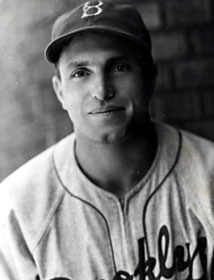The 1941 World Series began a rivalry that was among the most fierce and passionate in baseball: the Dodgers and the Yankees. Now that it’s cross country, it’s a little less passionate, but nonetheless the intensity is still there. The first games in that rivalry were in Yankee Stadium.
Game 1: 1 October 1941
Game one saw the Yankees start Hall of Fame right-hander Red Ruffing against Curt Davis. New York struck first with a Joe Gordon home run in the bottom of the second. The 1-0 score lasted until the bottom of the fourth when, Joe DiMaggio drove a long fly to left. Joe Medwick, grabbed the top of the fence, hoisted himself up, and snagged the ball going out of the field of play (sort of like the more famous Al Gionfriddo catch of 1947). That gave New York two outs. But then Charlie Keller walked. Bill Dickey promptly doubled to score Keller and run the score to 2-0.
The Dodgers got the run right back in the top of the fifth, again with two outs. PeeWee Reese singled and scored on a follow up triple by catcher Mickey Owen. The score remained 2-1 until the bottom of the sixth when, this time with only one out, Davis again walked Keller. A Dickey single sent Keller to third and a Gordon (who went 2 for 2 in the game with a walk) single brought home Keller with the third New York run. It also sent Davis to the bench and brought in ace reliever Hugh Casey, who got out of the inning with consecutive flies.
Brooklyn again got the run right back in the top of the sixth. Cookie Lavagetto reached first on a throwing error by Yanks shortstop Phil Rizzuto. A Reese single sent Lavagetto to second and Lew Riggs pinch hit for Owen. Riggs singled to plate Lavagetto, but a double play and a ground out ended the inning with the score 3-2. It stayed that way through the eighth when Ruffing gave up two singles sandwiched around a foul. That brought up Dodgers catcher Herman Franks (who was in the game because Riggs had pinch hit for Owen). He hit one to Gordon, who flipped to Rizzuto who threw on to first to end the inning and the game on a nifty double play.
The big stars were for the Dodgers, Medwick, who’s great catch saved a run and for the Yankees, Ruffing who pitched a complete game and Gordon who drove in two runs and scored one. The game gave New York a 1-0 Series lead.
Game 2, 2 October 1941
Game 2 saw New York trot out Spud Chandler to face Brooklyn ace Whit Wyatt. At the beginning of the game, Chandler seemed more the ace than Wyatt. The Dodgers gave up runs in both the second and third innings. It could have been worse. With two outs and Charlie Keller on third and Joe Gordon on second, Chandler singled to score Keller, but an alert play by Dolph Camilli, Dodgers first baseman, gunned Gordon down at the plate to end the inning. In the third, Tommy Henrich doubled and after an out, came home on a Keller single.
After that Wyatt settled down. He gave up a couple of walks and a handful of hits, but no Yankee scored. Meanwhile, the Dodgers finally got to Chandler in the fifth. Walks to Camilli and Cookie Lavagetto were bookends to a Joe Medwick double that loaded the bases and brought up Brooklyn shortstop PeeWee Reese. Reese grounded to his counterpart, Phil Rizzuto. Rizzuto flipped to Gordon to get Lavagetto, but Reese beat the relay and Camilli scored while Medwick went to third. That brought up Mickey Owen, who singled home Medwick to tie the score.
In the top of the sixth, Dixie Walker reached first on a Gordon throwing error and went to third on a Billy Herman single. That gave Chandler an appointment with the showers and brought in Yankees relief ace Johnny Murphy. Camilli singled to untie the game and the Dodgers held on to win 3-2. Wyatt ended up with a complete game victory while Chandler took the loss.
Game 3, 4 October 1941
After a day off and with the Series tied one game each, the teams moved to Ebbets Field for game three. It was the first postseason game played in Ebbets Field since 1920. The Dodgers gave the ball to Fred Fitzsimmons. The Yanks countered with Marius Russo.
For seven innings it was a great pitchers duel. No on scored. Only one man on each team (Joe Gordon and Pete Reiser) made it as far as third. By the eighth, Fitzsimmons was almost out of gas. Then he got hit on the foot by a batted ball. He’d given up four hits and walked three, while striking out one, but he just couldn’t go on with the foot hurting. So Leo Durocher decided he had to go to his bullpen. In came Hugh Casey, the Dodgers counterpart to Johnny Murphy. He got the first out, then consecutive singles by Red Rolfe and Tommy Henrich brought Joe DiMaggio to the plate. He singled to left scoring Rolfe and sending Henrich to third. Charlie Keller was next and singled scoring Henrich. That was all for Casey. Larry French replaced him and recorded the final out of the inning.
Leading 2-0 Russo started the bottom of the eighth by giving up a Dixie Walker double. One out later French was removed for a pinch hitter, who struck out. That brought PeeWee Reese to the plate. He singled scoring Walker before Russo got a popup to end the inning. He sailed through the ninth to record a Yankees 2-1 win and put New York up 2 games to 1. Game four was Sunday and would become the most famous, of infamous depending on your point of view of the entire Series.








